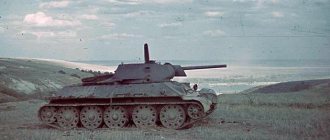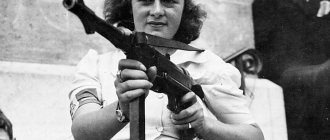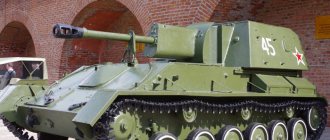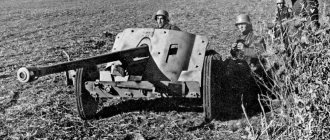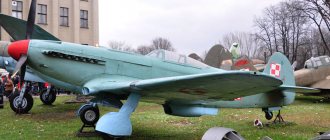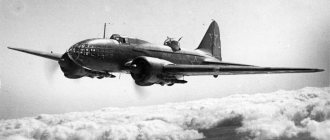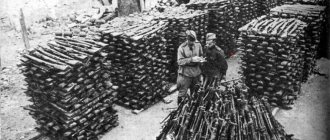Introduction
The USSR won the Great Patriotic War not only thanks to the heroism of its soldiers, the talent of its commanders and the work of workers and collective farmers in the rear. The USSR also won because its army fought with the best weapons of its time. The weapons created in the pre-war years fully met the requirements for them. This was shown by the experience of combat operations. At the same time, the dynamic nature of combat operations and the further development of combat tactics necessitated the development of a number of new types of small arms, as well as the improvement of existing equipment.
Purpose of the study: to determine the role of technical achievements during the Great Patriotic War. For this, the following tasks were set:
- Study weapons from the Great Patriotic War.
- Highlight the main distinctive features of the types of weapons being studied.
- Give examples of feats using certain types of Soviet weapons.
Research hypothesis: if during the Great Patriotic War there had not been a rapid development of the weapons of the Soviet Army, then perhaps this would have influenced the course of the Great Patriotic War.
By June 22, 1941, the Soviet Union had a bloodless army. The command staff was practically destroyed, the army was armed with outdated equipment. On the contrary, all of Europe worked for Germany. Therefore, the start of the war was unsuccessful for the USSR; it took some time to mobilize forces and create new equipment.
The difficult international situation of the thirties and early forties required the implementation of urgent measures to strengthen the Soviet armed forces. It was necessary to re-equip the troops with the latest models of military equipment. To achieve this goal, specialized research institutes, design bureaus and laboratories were created.
At the same time, many wrong decisions were made. Unjustified repressions of a number of highly qualified scientific specialists had a serious impact on the pace of rearmament of the Soviet Army.
The catastrophic defeats of the initial period of the war forced the country's military-political leadership to rethink the situation. It turned out that the Nazi troops were advancing with a wide variety of and not always first-class equipment, including captured weapons from previously defeated European armies. Most likely, the enemy’s rapid blitzkrieg is ensured mainly by two years of successful experience in conducting military operations, the professional training of well-trained East Prussian generals, “correctly” carried out ideological work with personnel, and also, last but not least, traditional German punctuality, organization and discipline.
The contribution of scientists to the cause of Victory
The top military leadership came to the conclusion that, subject to the full mobilization of the remaining scientific, technical and production reserves, it would be possible to give a convincing response to the enemy. The Academy of Sciences was tasked with immediately speeding up research. All her activities were now subordinated to three goals:
- designing new means of defense and offense;
- scientific assistance to the arms and ammunition manufacturing industry;
- finding new raw materials and energy resources, replacing scarce materials with cheaper and more accessible ones.
Preparing for war with the USSR, the Nazis hoped to destroy the bulk of our fleet with the help of secret magnetic mines. On June 27, 1941, an order was issued to organize teams for the urgent installation of demagnetizing devices on all ships of the fleet. Anatoly Petrovich Alexandrov was appointed scientific director. Professor Igor Vasilyevich Kurchatov voluntarily joined one of the teams.
The work was carried out almost around the clock, in the most difficult conditions, with a shortage of specialists, cables, equipment, often under bombing and shelling. A winding-free demagnetization method was also created, which was used to protect submarines from magnetic mines. Mikhail Vladimirovich Keldysh found out the reason and created a theory of a very complex and dangerous phenomenon - self-excitation of oscillations with large amplitude near the wings and tail of an aircraft (flutter), which led to the destruction of the machine - this helped to develop measures to combat flutter.
As a result of the research of Doctor of Technical Sciences Nikolai Mikhailovich Sklyarov, high-strength armor steel AV-2 was obtained, containing significantly less scarce components: nickel - 2 times, molybdenum - 3 times. Research by scientists from the Institute of Chemical Physics of the USSR Academy of Sciences Yakov Borisovich Zeldovich and Yuli Borisovich Khariton helped to switch to the use of cheaper gunpowder. To increase the flight range of a rocket, scientists have proposed lengthening the charge, using more high-calorie fuel, or using two simultaneously operating combustion chambers.
In the history of the activities of Leningrad scientists, there is a heroic episode associated with the “Road of Life”: a circumstance, at first glance, completely inexplicable, was revealed: when the trucks went to Leningrad, loaded to the maximum, the ice withstood it, and on the way back with sick and hungry people, i.e. e. with significantly less cargo, the vehicles often fell through the ice. Pavel Pavlovich Kobeko, a researcher at the Institute of Physics and Technology, developed a technique for recording ice vibrations under the influence of static and dynamic loads. Based on the results obtained, rules for safe driving along the Ladoga highway were developed. Ice accidents have stopped. Scientists were actively involved in work that was new to them.
We must not forget that repressions did not stop during the war. Under the leadership of the NKVD, secret design bureaus were created, which were popularly called “sharashki”. Many outstanding scientists, unfairly accused of any crimes, worked here in prison conditions. An example of this can be Andrei Nikolaevich Tupolev, under whose leadership the best front-line dive bomber Tu-2 was created. The scientist was accused of organizing a Russian-fascist party, arrested, and threatened to put his wife in prison and send his children to an orphanage. The conditions were set for him: “The plane is in the air - everyone goes home.” Tupolev confessed to something he did not do. For his developments, he asked to return the sick, dying Sergei Pavlovich Korolev from the stage. Ideal conditions for work were created at the “sharashka”: normal food, sleep, shower. But there was no freedom. Scientists would have designed without these ideal conditions, since they were true patriots and professionals in their field.
- The weapon with which Victory was forged
- The most popular machine
The Soviet infantry began the war armed with an outdated Mosin rifle, adopted for service at the end of the 19th century. After each shot it had to be reloaded. In terms of rate of fire, the rifle could not compete with the German “Schmeisser”, which almost all German soldiers were armed with. Even before the war, Soviet designers began producing automatic weapons. G.S. coped with this task best of all. Shpagin. The submachine gun (PPSh) he created had an extremely simple design. Its production did not require much time or complex equipment. The ease of manufacture ensured mass production of the PPSh from 1941-1945. More than 6 million PCA were collected. This is an absolute record among weapons of the Second World War. As soon as he appeared in the army, the PPSh immediately won the love of the soldiers. When the Germans approached Kashira, Stalin’s question “how can I help?” the commander of the city’s defense replied, “send at least a few dozen PPSh.” Stalin really liked the PPSh and it was he who insisted that the PPSh have a disk-type, more capacious magazine.
3.2. Sudaev submachine gun
PPS-43 (Sudaev submachine gun) - a submachine gun was developed by Soviet designer Alexey Ivanovich Sudaev in 1942. It was decided to establish production of the new PPS assault rifles put into service in besieged Leningrad. The supply of weapons there was difficult, and the front required replenishment. Not inferior in combat qualities to the Degtyarev submachine gun and the Shpagin submachine gun, it was 2.5 kilograms lighter than them, and required 2 times less metal and 3 times less labor during production.
- "Thirty-four"
A year before the start of the war, the first T-34 tank was created at one of the Kharkov factories. The machine was created in a design bureau headed by engineer M.I. Koshkin. The new tank embodied many original ideas that were ahead of world tank construction. The armor of the 34's hull had a strong slope, which caused the shells to ricochet off. The T-34 at birth received a long-barreled 76-mm gun. From a distance of 1000 meters it easily penetrated 60mm thick armor. For comparison, German tanks at the beginning of the war were all armed with short-barreled small-caliber guns. After the Battle of Kursk, when Soviet medium tanks had to fight German heavy Tigers, Stalin ordered the T-34 to be equipped with a more powerful 85 mm cannon. To do this, the tank's turret had to be enlarged. The T-34 ran on diesel fuel, which significantly reduced the risk of fire. German tanks used gasoline engines and, if hit by a shell, burned like candles. Wide tracks provided good maneuverability. During testing, the “thirty-four” broke pine trees 70 centimeters thick, and on the battlefield it boldly went to ram enemy tanks. Military experts recognized the T-34 as the best tank of World War II. The appearance of the "thirty-four" on the battlefield was an unpleasant surprise for the German army. General Guderian, the creator of German tank warfare doctrine, wrote in his memoirs: “Many T-34s entered combat and inflicted heavy damage on German tanks. If before that we had superiority in tanks, now the situation is reversed.”
- Legendary Katyushas
On June 21, 1941, literally a few hours before the war, the People's Commissariat of Defense, after successful tests, decided to mass produce BM-13 rocket launchers - the famous Katyushas. BM-13 was developed in a design bureau headed by Andrei Grigorievich Kostikov. A launcher of 16 guides was attached to the 3-ton truck, each of which held a 132-mm rocket. The guides could be raised and rotated on the sides, which made it possible to fire in different directions. The salvo was produced by closing electrical contacts in a device located in the driver's cabin. In 10 seconds, one Katyusha fired 16 rockets that flew at a distance of up to 8 kilometers. In 1940, the BM-13 was tested. At the training ground in the presence of People's Commissar of Defense S.K. Timoshenko and Chief of the General Staff G.K. Zhukov conducted demonstration shooting. The place where the shells fell turned into ashes. A regiment of 36 Katyushas could destroy all life in an area of 1 square kilometer. Each vehicle had a box of explosives and a fuse cord. If there was a risk of the equipment being captured by the enemy, the crew was obliged to blow it up and thereby destroy the rocket systems. The installations were so secret that it was even forbidden to use the commands “fire”, “fire”, “volley”. Instead they sounded “sing” or “play”, which may also have been associated with the song “Katyusha”. And for the infantry, a salvo of Katyusha rockets was the most pleasant music. There is no single confident version of why BM-13 rocket launchers began to be called “Katyushas”; there are several assumptions.
The first assumption is based on the title of Blanter’s song “Katyusha”, which became popular before the war, based on the words of Isakovsky. The song was probably the catalyst for the name due to other influences.
The second assumption is from the abbreviation “KAT” - “Kostikovsky automatic thermal”. By the name of the project manager, Andrey Kostikov.
The third option - the name is associated with the "K" index on the mortar body - the installations were produced by the Kalinin plant. And front-line soldiers loved to give nicknames to their weapons. For example, the M-30 howitzer was nicknamed “Mother”, the ML-20 howitzer gun was nicknamed “Emelka”. Yes, and the BM-13 was at first sometimes called “Raisa Sergeevna” - RS (missile).
Before the war, they did not have time to conduct military tests and they decided to conduct them right at the front in real combat conditions. Since the Katyusha was classified, officers were selected from students of the artillery academy. Captain Ivan Flerov was assigned to command the battery of 7 Katyushas. All received short training in operating the BM-13. On June 2, 1941, the battery began moving from Moscow to the west. They moved at night so as not to come under fire from fascist aircraft. Soon, reconnaissance reported a large concentration of the enemy at the Orsha station. On July 14, being 5 km from Orsha, Flerov gave the command “Fire!!!” In a few seconds, 112 rockets flew towards Orsha. This is how the Germans first learned the power of Katyusha, and immediately declared a hunt for it. On October 7, Flerov’s battery was ambushed, and the commander gave the command to blow up the BM-13s so that they would not fall to the enemy. This is how Russian soldiers and combat vehicles died the death of the brave. Nothing equal to Katyushas was created during the war years in any country.
- "Flying Tank"
On the eve of the war, Sergei Ilyushin's design bureau developed an attack aircraft designed to support advancing infantry and destroy enemy armored vehicles. The car received the name Il-2.
Since the aircraft had to fly low over the battlefield, its vital components were reliably protected by armor. The armored body, which resembled a capsule, was located in front of the fuselage. Inside it, protected by a 10-mm curved steel sheet, were the engine, cockpit, and gas tanks. The armored hull, weighing about 700 kilograms, played the role of a supporting structure: the wings and tail were docked to it.
IL-2 received powerful weapons. It was equipped with two 23-mm cannons, which easily penetrated the thin armor covering the tanks from above. In addition, the plane carried about 400 kg. bombs and 8 unguided rockets, similar to those the Katyushas were armed with. Il-2, protected by armor and having powerful weapons, received the nickname “flying tank”.
Initially, the Il-2 was a single-seat aircraft. However, the first battles showed that German fighters were approaching his tail, which was not protected by anything, and shooting him down. It was necessary to install a place behind the cockpit for a gunner armed with a heavy machine gun, protecting the aircraft during an attack from behind. Il-2 losses dropped sharply.
The IL-2 proved itself best in the fight against German tanks. Near Kursk, to destroy fascist armored vehicles, our pilots used cumulative (directed) anti-tank bombs for the first time. The bomb weighed only 1.5 kg, but easily burned through 70 mm armor. The bomb bays of the Il-2 could accommodate up to 200 such bombs. The plane dropped them onto a concentration of tanks, armored personnel carriers, and self-propelled artillery installations. Pilots of the 291st Attack Aviation Division, flying the Il-2, destroyed and damaged more than 400 enemy tanks in five days of the Battle of Kursk. Namians nicknamed the IL-2 “black death”.
IL-2 had fantastic survivability. More than 500 holes were counted on one of the attack aircraft that returned from a combat mission. Another plane had a piece of its propeller blade about 40 cm long knocked off by an enemy shell, but the pilot managed to bring the plane to the airfield. The pilots joked about this wonderful machine: “Il gets you out of battle on your word of honor and one wing.”
The Ilyushin attack aircraft became the most popular aircraft of the Soviet air force during the Great Patriotic War: 41 thousand Il-2s were produced.
- "The Fuhrer's Personal Enemy"
During the war, submarines were the most popular class of ships in the USSR Navy. Submarines were used for various purposes. They sank fascist warships and transport with torpedo strikes and laid minefields on enemy sea lanes. Troops and reconnaissance were landed from submarines on the enemy shore. The submarine's usual armament consisted of torpedoes and cannons. Torpedoes could hit enemy ships at a distance of up to 10 km. They could be launched from both underwater and surface positions. The guns were intended to fire at enemy ships and coastal fortifications.
The C-type medium submarine was considered one of the best Soviet submarines. It was more than 70 meters long and powerfully armed: six torpedo tubes and two cannons. The submarine was served by a crew of 47 people.
Type C submarines were capable of diving to depths of up to 100 meters. Their autonomous voyage time (without refueling) was 30 days. During this period, she could cover a distance of 8 thousand nautical miles. Thus, this submarine was used to fight enemy ships in the open seas far from their bases.
The C-type submarine, with the seemingly unlucky number 13, accomplished one of the most outstanding feats in the history of the Navy.
It was January 1945. The Red Army fought bloody battles for Poland. Soviet troops were besieging the port city of Danzig (Polish Gdansk). The Germans hastily prepared for evacuation. There were ships at the ready in the port, among which was the pride of the German passenger fleet, the liner Wilhelm Gustlow. In 1938, Hitler personally participated in the launching of this ship. Now the Wilhelm Gustlov had to evacuate several thousand submariners to the German port of Kiel: there was a special school for their training in Danzig. In addition to the sailors, the ship housed fascist officials and members of their families who were fleeing. The mayor of Danzig occupied Hitler's personal apartments. The ship took on board about 6 thousand people, three times more than expected. People even filled the drained pool. On the night of the departure of the Wilhelm Gustlov, the Soviet submarine S-13, commanded by Captain 3rd Rank Alexander Marinesko, quietly entered Danzig Bay. On January 30, a strong storm broke out at sea, visibility was poor. The boat surfaced, and observers began to peer into the distance, looking for a target. In the evening twilight they saw the silhouette of a huge ship. It was the Wilhelm Gustlov, accompanied by a cruiser, several destroyers and minesweepers. The liner was moving between the convoy and the shore. It was impossible to attack him from the sea. Marinesko decided on a dangerous maneuver: to attack the liner from the shore. The submarine dived and, surfacing between the ship and the shore, fired a salvo of three torpedoes. There were three explosions. After 15 minutes, “Wilhelm Gustlov” disappeared under water. Of the 6 thousand people, about a thousand were saved. “S-13” miraculously escaped pursuit. Already returning to shore, she sank another German transport with 3.5 thousand soldiers and officers on board. Upon learning of the death of “Wilhelm Gustlov,” Hitler was furious. He ordered the head of the convoy to be shot, and declared Marinesko his personal enemy.
Weapon of Victory
The experience of the First World War and the Civil War convincingly showed that the very existence of the Soviet state is impossible without taking urgent measures to equip the Red Army with the latest military equipment. Among the various types of this equipment, automatic weapons were given one of the first places.
Even during the difficult years of the Civil War and the subsequent devastation of the economy and production, funds were found and work began to design new automatic weapon systems and create an appropriate base for their development and production.
7.62 mm submachine gun mod. 1940 (PPD-40). In the archival photo, the PPD submachine gun has a sector sight, in the top photo there is a simplified two-position rear sight made during wartime
For this purpose, in Kovrov, on the basis of the “Special Workshop”, the first design and construction bureau in our country was created, which for a long time was headed by the wonderful Soviet gunsmith V. A. Degtyarev, and in organizing and establishing the work - the creator of the world’s first machine gun, V. G. Fedorov. Based on the work of the PKB, the level of constructive development of new weapons significantly increased and a cadre of designers were trained, in many ways surpassing their teachers (G. S. Shpagin, S. G. Simonov, P. M. Goryunov, etc.)
7.62 mm Maxim machine gun mod. 1910/30 modernized during the war (1941-1944)
The Tula design school was also traditionally strong, represented by S. A. Korovin, F. V. Tokarev, N. V. Rukavishnikov, S. V. Vladimirov and others. The shooting and tactical courses “Vystrel” played an important role in the shooting training of troops. the head of which was appointed the outstanding theorist and practitioner of small arms N. M. Filatov, who created major works on the foundations of rifle and machine gun shooting. Of great importance in the training of designers and scientists was the creation during the pre-war five-year plans of special departments of small arms and machine guns at the Artillery and Air Force Academies, the Tula and Leningrad Mechanical Institutes. Thanks to the scientific works of A. A. Blagonravov, E. L. Bravin, V. S. Pugachev, M. A. Mamontov, the design of weapons was put on a scientific basis.
As a result of the consolidation of intellectual potential, combat experience and the implementation of the country's industrialization plan, the development of the Red Army's weapons occurred in two independent directions. The first (in terms of small arms) was practically completed in 1930. Then the rearmament of the Red Army with modernized models of infantry weapons (7.62 mm Nagan revolver, 7.62 mm rifle model 1891/30 and 7.62 mm a Maxim machine gun, and later a carbine model 1938), which differed from its predecessors in improved operational and technological characteristics, which played an important role for the country’s economy in the pre-war years.
7.62 mm Tokarev self-loading rifle (SVT-40) with a bladed bayonet
Further work in this direction was intensified only after the start of the Great Patriotic War. The second direction of development implied the creation of new weapons that have no analogues not only in domestic, but often in world weapons practice. At the same time, what is surprising is a truly scientific, systematic approach to solving the problem (which is so lacking these days) - it was the weapon system that was to be developed (consisting of a pistol, submachine gun, self-loading rifle, anti-tank rifle, light, heavy and heavy machine guns, rifle grenade launcher and a 50-mm company mortar), designed to function according to the general tactical requirements of the Infantry Combat Manual (in accordance with which the required accuracy and efficiency of fire, rate of fire, effective range, firing modes, maneuverability were determined) when operating as part of units in various types of combat, reinforced requirements for reliability and safety, maintenance and repair.
7.62 mm submachine gun mod. 1941 (PPSh-41) with a simplified two-position rear sight and a two-row sector magazine with a capacity of 35 rounds
The first result was obtained already in 1927 - the first domestic light machine gun DP (Degtyarev infantry) was adopted for service, designed to replace the extremely worn-out light machine guns of various foreign systems, inherited from the times of the First World War and intervention. The machine gun was warmly received by the troops and highly praised for its fire power and ease of design and maintenance. In 1928, its aviation modification in a turret version - the DA machine gun - entered service, and in 1929 a tank modification - DT. Moreover, no one had any illusions regarding the survivability of the tanks - the DT machine gun was equipped with a kit for use in the infantry version (bipod with a sight). Unfortunately, few people learn the lessons of history; modern tank machine guns do not have such a set and cannot be used for firing if the tank fails. But some armored vehicles have as many as three machine guns (BMD-1). And the point here is not in the technical complexity of the task (after the defeat of a tank column in Grozny, Shevchenko and Danilov developed and tested it), but in criminal thoughtlessness. But let's return to our story.
So, the “first pancake” turned out to be far from lumpy. The operation scheme of the automatic machine gun and the design of the bolt locking unit turned out to be so successful that they formed the basis for the development of both easel (DS-39), and large-caliber (DShK model 1938), and manual chambered for the cartridge model 1943 (RPD-44 ) machine guns. In the development of submachine guns, Vasily Alekseevich also achieved the best results - in 1934, the PPD-34 of his design was adopted, which underwent two successive modernizations in 1938 and 1940, but still the cost was close to the cost of a light machine gun.
7.62 mm Degtyarev heavy machine gun (DS-39)
The competition to create a self-loading pistol ended with the adoption of a 7.62 mm pistol mod. 1930 (short name of TT - “Tula Tokarev”). True, just three years later the pistol underwent modernization in order to simplify and reduce the cost, taking on the well-known appearance and name - pistol mod. 1933
7.62 mm pistol mod. 1933 (TT)
Taking Browning's automatic operation scheme as a basis, F.V. Tokarev created his own original design, the viability of which has been tested by time and experience in combat use in dozens of wars and local conflicts. Things were somewhat more complicated with the development of a self-loading rifle. At first, S.G. Simonov was in the lead in the competition, and the political desire to have the most progressive main infantry weapon overshadowed common sense and the still “raw” system was put into service in 1936 under the abbreviated name ABC-36.
Experience in the production and operation of the ABC-36 revealed shortcomings, the elimination of which would require a radical redesign of the rifle in terms of ensuring strength and reliability and would inevitably increase the weight. Under these conditions, Tokarev took the lead with his SVT-38, which was also not without its shortcomings, but not of a constructive nature, but rather of a technological nature (it turned out to be expensive in mass production), which led to its modernization in 1940. Along the way, the weight was reduced and increased reliability of automation.
7.62 mm revolver mod. 1895
So, the USSR became the first state in the world to have a mass-produced self-loading rifle in its infantry arsenal. The achievement in this area was convincingly demonstrated to the whole world by equipping honor guard companies with self-loading weapons. The SVT served as a “ceremonial” weapon until it was replaced by the Simonov SKS. The development of anti-tank rifles, which began vigorously in the late 20s and early 30s, gradually faded away, ending with the creation of a number of prototypes and the accumulation of experience in their development. However, even in the German army they were quite skeptical about the effectiveness of the combat use of this type of weapon. New and modernized models gained experience in combat use in the harsh conditions of local conflicts on Lake Khasan and the Khalkhin Gol River and in the Soviet-Finnish War of 1939-40, where an invaluable store of knowledge was obtained about the actual use of weapons in the army (often by poorly trained personal composition) implemented in test procedures. After all, the obvious haste in adopting some models is explained not only by external threats, but also by the lack of testing experience (almost everything was done for the first time) and evaluation of the results, and the weakness of the methodological and material and technical base of testing.
Underestimating the combat effectiveness of submachine guns cost our troops dearly in the war with Finland, and it was not possible to significantly increase their production in the shortest possible time due to the high labor intensity and cost. It was possible to fill this gap in record time - nine months after the end of the Finnish company (taking into account the time of the announcement of the competition, development and testing) in December 1940. A sample of the design of Georgy Semenovich Shpagin under the name 7.62-mm submachine gun was adopted for service. arr. 1941 (abbreviated PPSh). “Daddy,” as the soldiers affectionately called him, while maintaining all the positive qualities of the PPD, was distinguished by enviable manufacturability due to the use of cold stamping in the production of the main parts. It was the timely appearance of this, the most popular submachine gun of the Second World War, that became the key and one of the symbols of the future Victory.
7.62 mm Goryunov heavy machine gun (SG-43)
So, by June 22, 1941, the Red Army had one of the most advanced small arms systems in the world. Obviously, the army did not receive all types of weapons in sufficient quantities, but the failures of the first period of the Great Patriotic War are not associated with poor equipment of the troops, but with miscalculations of the country's leadership and army command, because both Germany and its allies used obsolete weapons in significant quantities during the First World War, and a huge number of the latest Soviet models, taken as trophies, were immediately put into service. SVT rifles, PPD and PPSh submachine guns, DP and DShK machine guns were especially popular in the German ground forces. A captured SVT could be sold for 400 Reichsmarks, which was almost two months' salary for a company commander. With German pedantry, as well as with Finnish frugality and unspoiledness, even DS-39 machine guns worked flawlessly, but in our country, at the beginning of the war, DS production was curtailed. The dramatic fate of this machine gun has been little studied to this day and requires a separate narrative.
7.62 mm rifle mod. 1891/30
The beginning of the Great Patriotic War convincingly showed that the development trends of small arms developed in the 20s provided for even the most incredible development of events when repelling external threats (the official doctrine demanded “with little blood and on foreign territory”). No one could even imagine that within a month or two after the enemy’s invasion, the main industrial areas of the country would find themselves in occupied territory, and the army would lose the lion’s share of the most modern weapons concentrated in the border districts. This is where the results of the weapons modernization work carried out in the pre-war period (and which received additional acceleration after its start) were assessed, which significantly reduced the material intensity and labor intensity of manufacturing products, which ultimately made it possible to meet the needs of the army.
Already in the first border battles with the massive use of tanks, the half-forgotten issue of developing an anti-tank rifle arose. Pre-war developments in this direction (including the development of the 14.5 mm cartridge) allowed Degtyarev and Simonov to create domestic anti-tank rifles PTRD (single-shot with automatic unlocking and opening of the bolt) and PTRS (self-loading) in the shortest possible time, almost in a month. The first experience of combat use of PTRD took place on November 16, 1941 at the height of the Battle of Moscow. Already in the first clashes they showed high combat effectiveness, and from that time on they became an indispensable component of anti-tank defense, to strengthen which entire companies of armor-piercing soldiers were formed. Even after the appearance of heavy enemy tanks in 1943, which PTRs could no longer effectively fight, this class of weapons did not become obsolete and was actively used until the end of the war to combat firing points, lightly armored and unarmored vehicles.
14.5-mm anti-tank rifles: on the left - Degtyarev (PTRD), on the right - Simonov (PTRS)
Despite the difficult economic situation of the country, work on improving and developing new models did not stop throughout the war. Already in the first offensive operations of the Red Army, the need was identified for a light and compact submachine gun to arm scouts, sappers, crews of combat vehicles and artillery crews. Alexey Ivanovich Sudaev coped with this difficult task superbly. His PPS-42 successfully passed military tests in the harsh conditions of the wooded and swampy terrain of the Leningrad Front and, with some modifications, was put into mass production under the name “7.62-mm submachine gun mod. 1943" (abbreviated as PPS-43). The combat qualities of the PPS amazed even modern gunsmiths. In 2000, when testing their samples of submachine guns developed during the Baksanets R&D process, one of them, seeing the result of the PPS firing, barely whispered: “Everything has already been done before us...”. In general, the “turning point” year of 1943 became the starting point for the birth of “offensive” weapons, lighter and more maneuverable, better suited to the requirements of offensive combat.
7.62 mm submachine gun mod. 1943 (PPS-43) with a two-row sector magazine with a capacity of 30 rounds
In addition to the PPS, P. M. Goryunov’s heavy machine gun (SG-43) is being adopted and a 7.62-mm carbine is undergoing military testing (the following year it was named Model 1944 and replaced the Model 1891/30 rifle in production .). In 1944, Degtyarev, after analyzing the shortcomings identified during combat operation, modernized the DP light machine gun, which received the name DPM.
In addition, even at the very height of the war, the foundations of the post-war weapons system were laid - Elizarov and Semin worked on an “intermediate” cartridge, called the 7.62-mm cartridge mod. 1943, and venerable gunsmiths (Degtyarev, Simonov, Sudaev, etc.) began work on samples for it. In the same 1943, the still unknown Mikhail Timofeevich Kalashnikov began professional weapon design.
7.62-mm modernized Degtyarev light machine gun (DPM) Concluding a brief overview of the development of small arms in pre-war and wartime, it is necessary to especially note the invaluable contribution of domestic gunsmiths to the Victory over Nazi Germany. Almost all of the mentioned weapons, created by their tireless work, served for many years as a guarantor of security not only for our country, but also for the entire democratic community. When designing the material, images of samples stored in the Military Historical Museum of Artillery, Engineering and Signal Corps in St. Petersburg were used. Photo images - Mikhail Degtyarev
